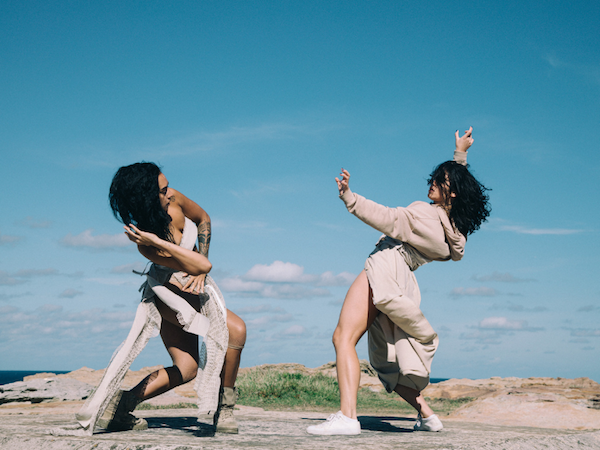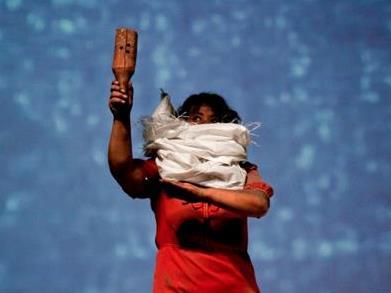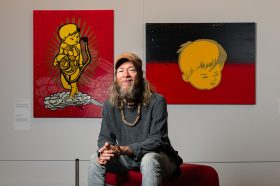Latai Taumoepea’s work exhibited in Stitching the Sea (2018) at Blacktown Arts; courtesy the artist. Photo credit: Katy Green Loughrey.
At a time when decision makers appear to be ignoring the urgency of the climate change message, artists, museums and communities, more than ever, have a responsibility to ensure that message is truly heard.
Casula Powerhouse Arts Centre, Blacktown Arts and the Australian Museum have come together to do just that. Oceania Rising: Climate Change in Our Region is a joint program of exhibitions, workshops, talks, film screenings and residencies directed at making real change.
Connecting the program across the three institutions is a communal desire to help people think through the issues and become truly engaged. ‘It was really a shared passion and the timing was right,’ said Jenny Newell, Manager, Pacific and International Collections, Engagement, Exhibitions and Cultural Connection at the Australian Museum.
‘As the oldest museum in Australia, the Australian Museum has had a long heritage of opening up its collection to communities through outreach, but we want to do more,’ Newell said.
‘The Museum is concerned about how we understand the dynamics of climate change and its cultural impact, and it’s been great to work with Casula and Blacktown on issues that we feel are really paramount.’

Amrita Hepi, Sometimes I want bell hooks but what I need is better te reo (2017), video still; exhibited Wayfinders at Casula Powerhouse Art Centre; courtesy the artist.
Change starts with truth
‘Storytelling is at the centre of what we wanted to do with Oceania Rising – it is exactly what cultural institutions are good at,’ Newell told ArtsHub.
‘Museums are trusted sources of information, and that provides a platform of trust for peoples of Pacific nations to tell their stories and be heard by others in Sydney,’ she continued.
The connecting thread between the three institutions is the work of Samoan-born Australian artist Angela Tiatia. Three of her works have been acquired by the Australian Museum, and are being displayed at the three institutions over the course of the Oceania Rising program.
Tiatia’s epic three-channel video from the Museum’s collection, Tuvalu, was on display at the Australian Museum from March to October and is now part of the exhibition Stitching the Sea (22 September – 27 October) at The Leo Kelly Blacktown Arts Centre. Her work is shown alongside that of Latai Taumoepeau, who has been in residence at Blacktown for the Oceania Rising project.
Taumoepeau presented the work, Hg57, a participatory installation and rallying cry for climate change action. ‘My work is about empowering communities by developing our understanding of what global warming is, and how it’s impacting our local community, our pacific communities, and people in general,’ said Latai.
She told Newell that Blacktown will be getting 50 degree days this summer. Newell comments that climate scientists have recently predicted 50 degree summers for Sydney by the end of the century, but in Western Sydney temperatures are getting there already.
Newell explained: ‘Pacific artists and Pacific communities know what is going on in their home islands, on the front line of climate change – its intense storms, losses of land and rising temperatures – and they know that these climate impacts are coming to Sydney too’.
‘It’s important for the voices not normally heard – the people who are experiencing the challenges of Sydney’s temperature rises– are heard by the decision makers,’ she added.
The Oceania Rising program is designed to look at our region, and Australia’s future in relation to the region. ‘It is about raising understanding, about hearing voices across the boundaries that usually exist – between Pacific and other communities, between Sydney’s West to the city – and about creating a community engaged in the issues of climate change,’ said Newell.
In Wayfinders (6 October – 11 November) at Casula Powerhouse Art Centre, artists similarly respond to, and reflect upon, their personal understanding and research of climate change through an art making perspective.
It is about “finding our way” through examining the past, the present and the future. Artists include Adriana Lear, Amrita Hepi, Seinileva Huakau, Donita Hulme, Victoria Hunt, Robert Jahnke, Yasbelle Kerkow, Erna Lilje, Greg Semu, Talia Smith, Salote Tawale, Angela Tiatia and WeAve.
A day of discussions, Talanoa, will be held on 10 November (1.30-3.30pm), followed by the Pacifica Festival: Ao (day) Po (night), with performances, market stalls and Pacific food (3-9pm).

Tooling up for change
Newell said that people often think that they will be perceived as ‘an alarmist’ if they speak out about climate change, but in fact surveys show that there are very high levels of concern across Australian society. It is a conversation that needs to become part of everyday life.
Recent research in the UK found that while there is a lot of community concern about climate change, people are not talking about it. The group with the highest level of concern were young women, which was also the group least likely to speak out.
‘We want to encourage people to talk more about climate change – to talk about their worries and to speak about the issues with more confidence. This project is about helping people find some of those tools.’ Newell told ArtsHub.
You can get started by joining the discussion forum on the Australian Museum’s website.
Newell concluded: ‘Basically, we hope to encourage people in Sydney to learn from Pacific perspectives, and to move beyond acting as individuals and be part of communal action – to join the powerful groups that are out there – because it is adding to that visibility and voice that can make a difference.’
Oceania Rising: Climate Change in Our Region is jointly presented by Casula Powerhouse Arts Centre, Blacktown Arts and the Australian Museum. Visit australianmuseum.net.au for details.





